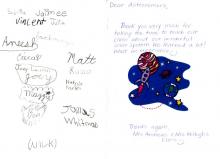Feed aggregator
Combination of cosmic processes shapes the size and location of sub-Neptunes
A combination of cosmic processes shapes the formation of one of the most common types of planets outside of our solar system, according to a new study.
Webb telescope captures its first direct images of carbon dioxide outside solar system
The James Webb Space Telescope has captured its first direct images of carbon dioxide in a planet outside the solar system in HR 8799, a multiplanet system 130 light-years away that has long been a key target for planet formation studies.
Age of upcoming asteroid flyby target
New modeling indicates the main belt asteroid (52246) Donaldjohanson may have formed about 150 million years ago when a larger parent asteroid broke apart; its orbit and spin properties have undergone significant evolution since. When NASA's Lucy spacecraft flies by this approximately three-mile-wide space rock on April 20, 2025, the data collected could provide independent insights on such processes based on its shape, surface geology and cratering history.
TOI-1453: Sub-Neptune in system of two exoplanets
Astronomers have discovered two exoplanets around TOI-1453, a star about 250 light years away. These two exoplanets, a super-Earth and a sub-Neptune, are common in the galaxy, yet are absent from our system. This discovery paves the way for future atmospheric studies to better understand these types of planets.
Weighing in on a Mars water debate
Water once existed in abundance of at the surface of Mars. How much of that water has been stored in the planet's crust is still unclear, according to a new analysis.
Detailed map of dust in the Milky Way
Astronomers have constructed the first detailed 3D map of the properties of cosmic dust in our home galaxy. For their map, the astronomers used 130 million spectra from ESA's Gaia mission, results from the LAMOST spectral survey, and machine learning. Dust makes distant astronomical objects appear more reddish and dimmer than they really are, so the new map will be an important tool for astronomers to make sense of their observations. The study has also revealed unusual properties of cosmic dust that will lead to further research.
Violent supernovae 'triggered at least two Earth extinctions'
At least two mass extinction events in Earth's history were likely caused by the 'devastating' effects of nearby supernova explosions, a new study suggests. Researchers say these super-powerful blasts -- caused by the death of a massive star -- may have previously stripped our planet's atmosphere of its ozone, sparked acid rain and exposed life to harmful ultraviolet radiation from the Sun. They believe a supernova explosion close to Earth could be to blame for both the late Devonian and Ordovician extinction events, which occurred 372 and 445 million years ago respectively.
Signs of alien life may be hiding in these gases
Scientists identify a new way to detect life in outer space with currently existing telescopes. The method hinges on worlds that look nothing like Earth, and gases rarely considered in the search for extraterrestrials.
Entwined dwarf stars reveal their location thanks to repeated radio bursts
A white dwarf and a red dwarf star have been discovered closely orbiting each other emitting radio pulses every two hours. Their findings means we know it isn't just neutron stars that emit such pulses, but these are spaced unusually far apart.
Black holes: not endings, but beginnings? New research could revolutionize our understanding of the universe
New research suggests black holes may transition into 'white holes', ejecting matter and potentially even time back into the universe, defying our current understanding of these cosmic giants.
Four tiny planets found orbiting one of our nearest stars
Astronomers have revealed new evidence that there are not just one but four tiny planets circling around Barnard's Star, the second-nearest star system to Earth.
Super-Earths and mini-Neptunes: More Earth-like planets may exist
A new study presents a compelling new model for the formation of super-Earths and mini-Neptunes -- planets that are 1 to 4 times the size of Earth and among the most common in our galaxy. Using advanced simulations, the researchers propose that these planets emerge from distinct rings of planetesimals, providing fresh insight into planetary evolution beyond our solar system.
Small, faint and 'unexpected in a lot of different ways': Astronomers make galactic discovery
The discovery of the dwarf galaxy Andromeda XXXV --located roughly 3 million light-years away and the smallest yet found in the Andromeda system -- is forcing astronomers to rethink how galaxies evolve in different cosmic environments and survive different epochs of the universe.
James Webb Space Telescope reveals unexpected complex chemistry in primordial galaxy
Astronomers have peered back to a time when the universe was just less than 300 million years old. The research team, using JWST revealed something extraordinary in the galaxy: significant amounts of oxygen.







